Gamification in healthcare apps, modern smart devices, and countless therapy avenues can gradually change user behaviors and make healthcare apps more adaptable, scalable, easier to use, and fun.
Healthcare has changed forever. The industry is experiencing challenges that have prompted medical institutions worldwide to adopt modern technologies and become more user-centric to better cope with stakeholders’ increasing demands and needs. Thankfully, this increase in demand has led to the industry’s digitization and rapid growth of countless mobile healthcare solutions to decongest the already occluded medical sector. Globally, the mobile healthcare market is expected to reach a value of $206 billion by 2026. That seems pretty far away, considering the industry is already showing signs of a far more rapid increase in value. Still, we don’t have to wait another five years to see the rise of mobile healthcare. According to the Institute for Human Data Science, more than 90,000 healthcare apps were released by the end of 2020. That’s an average of 250 mobile healthcare apps per day! This phenomenon has brought a myriad of benefits to the sector. Still, it has also made competition fierce. The quest for user retention means that healthcare app developers urgently need new, innovative solutions to capture user attention. Enter gamification in healthcare apps.
Healthcare apps can empower patients to manage their health conditions more actively, educate them, and help them be more independent through self-assessment and remote care solutions. They can also help healthcare professionals and other stakeholders treat and monitor their patients more efficiently, reducing workloads and taking some pressure off the system. However, the problem is that, with the increasing amount of competition in the mobile arena, healthcare apps need to deliver additional benefits that engage users and retain their attention. The fun factor brought by gamification can make mobile healthcare apps become more user-centric, boost stickiness, and modify user behaviors to improve health outcomes. For this reason, we consider gamification to be one of the most compelling and cost-efficient ways for healthcare app developers and healthcare companies to ensure the adoption of their apps. So let’s take a closer look at gamification in healthcare apps.

What is Gamification in Healthcare Apps?
If someone asks you to choose between Candy Crush and the Outlook app on your phone, you probably won’t hesitate to choose Outlook. Of course, you need Outlook for work or to read your emails but let’s face it, you have more fun and probably spend more time using Candy Crush. Here’s where the principle of gamification resides: people have more fun, therefore engage more, with apps that have game-like elements. This way, we can define gamification as applying game-related aspects and principles in non-game contexts to enhance the user experience and motivate app retention. Gamification and game-like features have been introduced in education, finances, fitness, and even business apps for many years with outstanding results. As a matter of fact, applying gamification principles to apps has shown to increase by 600% the registration of new users.
Furthermore, 83% of employees have stated that undergoing gamified training motivates them to learn and work better in the workplace. If those numbers aren’t convincing enough, the global gamification market is forecasted to reach around $12 billion by the end of 2021. This figure shows how effective gamification is and why healthcare app developers are implementing it quite effectively.
Gamification is becoming a pretty big deal in the healthcare arena: research predicts gamification in the healthcare market to reach $4.2 billion by 2022 and grow to a staggering $13.5 billion by 2025. Gamification is typically applied to healthcare apps to enforce medication adherence, encourage daily data recording, provide medical education, and communicate with physicians. In fitness and wellness apps (one of the most popular uses of gamification), it is usually implemented to help users reach specific goals. Whichever the case or the type of medical app, the strategy behind applying gamification in healthcare apps is to give rewards when users complete mandated tasks. Healthcare app developers usually employ this game-based approach in one or more of the following ways:
- Reward points: These are used to increase the perceived value of performing a particular task and act as visual identifiers of progress. In some cases, users can exchange them for in-app benefits.
- Badges: Badges give users a sense of achievement, motivate them to keep completing tasks, and stick to the app. Badges also help set milestones and accomplish personalized challenges, keeping users motivated and making the user journey easy to understand and less confusing.
- Leaderboards: These are used to create a competitive spirit. Users can share leaderboards with friends or other users to encourage the app’s usage.
In a more sophisticated scenario, there are also specialized healthcare apps targeted to users with visual, sensory, movement, or age impairments where gamification is an integral part of accessibility. These apps can include gamification by implementing real-time biofeedback from motion sensors and camera gestures. Whichever the case or the use of gamification in healthcare apps, ultimately, its purpose is to enhance the user experience and make interacting with the app a lot more fun. By doing so, gamification in healthcare apps can unlock user motivation and promote app adoption, which in the case of healthcare apps is crucial to improve health outcomes and bring significant changes to the medical industry.
5 Benefits Of Using Gamification in Healthcare Apps

Gamification Promotes Digital Engagement and Retention
Patient activation and retention are crucial for healthcare apps to fulfill their potential as promoters of successful health outcomes. Unfortunately, and despite their rising popularity, healthcare apps still have low retention rates. In 2020, healthcare apps saw 90-day user retention of only 34%, a low figure compared to the global app average of 48%. Healthcare apps also had an annual retention rate of merely 16%, while the macro app retention average was 35% by the end of the year. These figures highlight the importance of healthcare app developers finding new ways to increase user retention rates to ensure the apps they are shipping meet patients’ needs and help unclog the system. Here’s where gamification comes in.
Gamification in healthcare apps can help increase user retention and promote digital engagement by making users accountable for their health choices and turning them into engaged consumers who keep coming back for more, the same way it happens with real games. Players, or in this case patients, are increasingly motivated to keep using the app to reach new milestones, earn new badges, beat other users, and unlock more complex challenges. This way, gamification in healthcare apps can help people commit to the app and stick to using it daily to perform in-app activities they actually want to accomplish.
Moreover, gamification in healthcare apps appeals to users’ inherent appetite for healthy competition, personal growth, and social connectedness to build the motivators that can help users make the lifestyle changes that will result in better healthcare outcomes. Similarly, and regarding social connectedness, the prevalence of social media can help healthcare apps reach high adoption rates through gamification, mainly due to people’s increasing needs for socializing online. So, by encouraging users to share their app rankings, badges, and progress on social networks such as Facebook, users can gain a sense of accountability and will become more motivated to reach their goals by using the app.
With the help of gamification, healthcare apps can promote user digital engagement and retention, helping change their minds regarding the diseases they are suffering from and how they face them. In addition, Gamification in healthcare apps can take the tediousness away from healthcare apps and make them fun, engaging, and attractive via gaming models proven to promote user retention. This way, gamification can also help patients deal with depression, lack of knowledge and understanding about their illnesses, and poor engagement and adherence with their treatments.
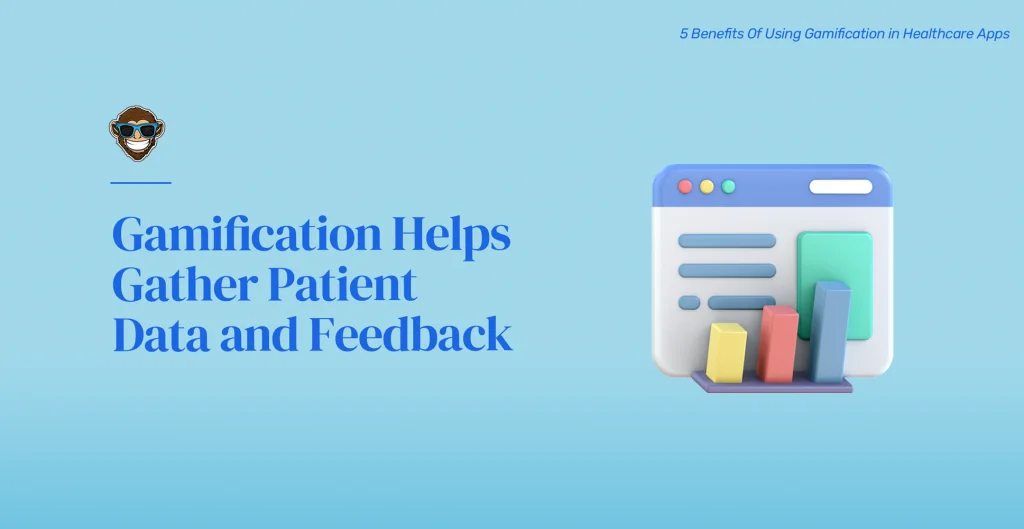
Gamification Helps Gather Patient Data and Feedback
As we’ve touched on in previous blog posts, data is the gold of the medical field. Data collection is the main priority when it comes to increasing product specificity, powering marketing endeavors, and improving medical services and outcomes. However, in most gamification uses for healthcare apps, the integration, accumulation, and analysis of user data isn’t typically the primary goal. Instead, gamification is implemented with the main purpose of increasing the retention and adoption of mobile products. Still, even though gamification’s primary goal is to cement user loyalty, data collection is an inevitable byproduct of using it in healthcare apps. Sounds good, huh? Gamification takes on the role of data collector when implemented in mobile healthcare scenarios because patients often have to compile and enter their personal and medical information into the app. This process is made less tedious and more trustworthy because the user’s conception of the app isn’t a medical one but rather a “playful,” relaxed one.
Similarly, creating a digital medical experience based on gamification, users will usually want to return to the app to keep advancing on milestones and challenges, resulting in effortless data collection. Take people with diabetes, for instance. A diabetic user can download an app, log their daily blood sugar levels and food consumption to receive medals or points and climb positions on a given reward ladder. This data serves as leverage for in-app (or in-game) advancement, but users can also share it with the user’s physician at the patient’s next appointment. By doing so, both healthcare providers and patients benefit from expedited treatment processes provided by swift data availability. In this sense, gamification in healthcare apps can be used as a very appropriate and efficient way of improving data collection for improving healthcare outcomes. Gamification truly is the gift that keeps on giving!
Additionally, when you gamify a healthcare app, the potential for motivating users to give more valuable feedback increases, helping healthcare companies and startups to find new business opportunities, identify trends, and address app issues more efficiently. Sadly though, tangible, usable feedback isn’t always easy to gather. Studies show that users don’t respond well to surveys and questionnaires, and more often than not, they fill them out mindlessly and without providing real, valuable insight. Thankfully, gamification in healthcare apps can help developers build better products that address the needs of their target audience more efficiently by leveraging accurate feedback. As a result, this invaluable feedback from users can help healthcare companies and stakeholders create relevant products that fully meet the requirements of the app’s target users, saving time and resources.
Moreover, when leveraged correctly, the healthcare data collected from gamified medical apps can help the industry’s players spot trends swiftly, increase product innovation, and build more user-centric product offerings based on actual customer needs. It can also help them make clearer-cut risk assessment forecasts and accurate planning. This priceless feedback and data collection can also help developers enforce better security protocols to prevent fraud and data leaks effectively and customize their products, not only for user demand but also for regulatory compliance.
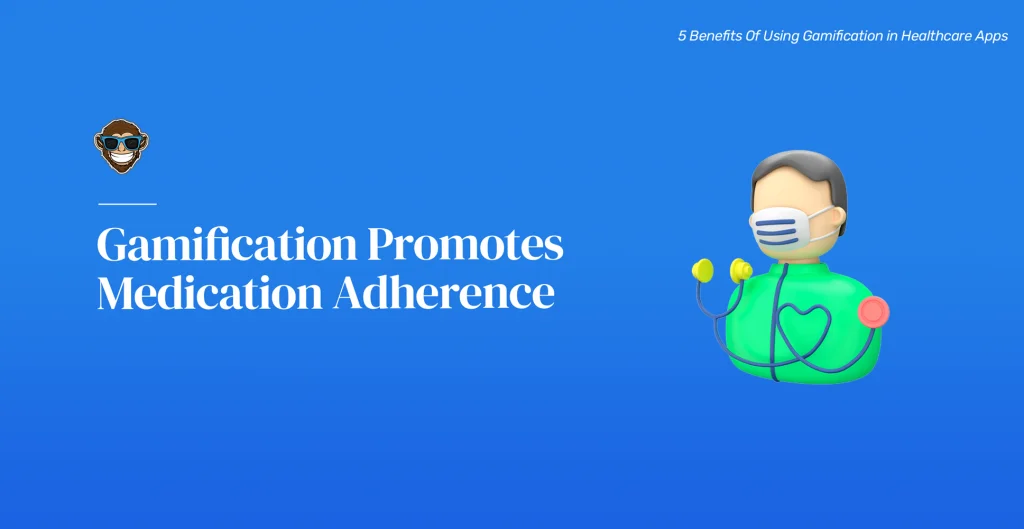
Gamification Promotes Medication Adherence
Medication and treatment adherence are two of the most influential aspects of positive healthcare outcomes. No surprise here; if you don’t take your meds, you won’t get better. However, medication non-adherence is an issue that impacts global healthcare systems and accounts for most of the progression of chronic and acute illnesses and poor health outcomes associated with them. On this matter, studies show that nearly half of the US population takes at least one prescription drug, with 1 in 4 taking three or more. Additionally, 20% to 30% of all medication prescriptions are never filled, and about 50% of medications for chronic illnesses are not properly taken. Moreover, lack of medication adherence costs the US healthcare system around $100 billion every year, a figure which could indeed be reduced by gamification in healthcare apps.
For the mobile healthcare ecosystem, gamification can promote medication adherence by fostering motivation and resilience and incentivizing the user’s need to fight their illnesses. In addition, gamified healthcare mobile products can be more engaging for patients. They can encourage them to enter their medication information, start tracking dosages, schedule the times for taking their pills, build medication programs, refill prescriptions, and even schedule doctor’s appointments. The best part? Users can accomplish all of this using interactive, reward-based, gamified models that feel more like a game and less like a chore. This phenomenon also serves as an intrinsic motivation for patients to educate themselves and self-manage their medical conditions. This way, patients are empowered to manage their diseases and are encouraged to keep hitting their goals by using the app, thus enhancing medication adherence.
Additionally, physicians can benefit from gamification by safely accessing the patient’s in-game data, helping them assess whether or not their patients are sticking to their treatments. In case they aren’t, the data from gamified healthcare apps can help doctors take necessary action. In this sense, gamification represents a viable, cost-effective alternative avenue to help stakeholders tackle treatment non-adherence and therefore becomes a significant opportunity for business and better healthcare outcomes.
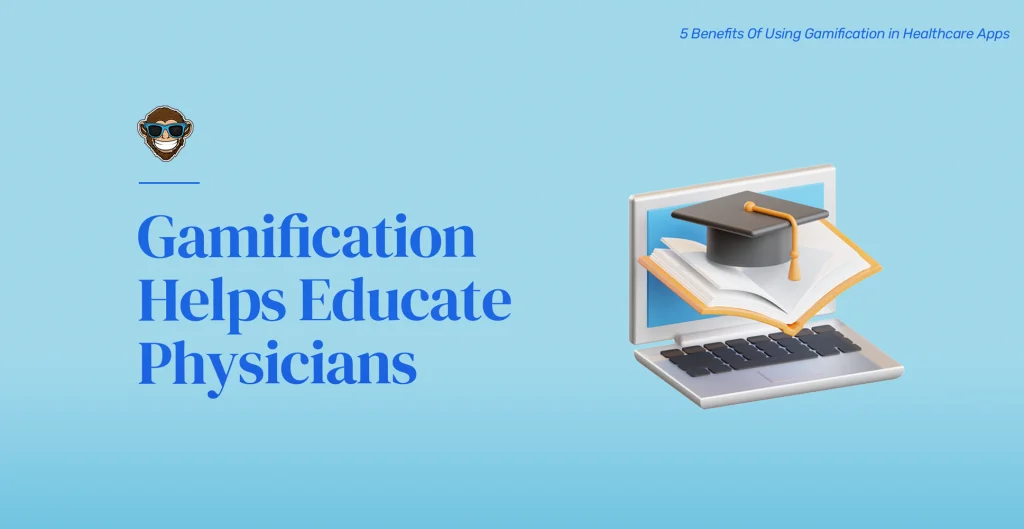
Gamification Helps Educate Physicians
This one we bet you didn’t see coming. As you probably already know, gamification has consistently been implemented for education purposes, and healthcare is no stranger to it. Physicians are increasingly using gamified medical apps to educate themselves about their fields and their patients. Sounds strange, we know. However, imagining your physician playing a game on his phone for learning purposes can be unusual.
Nonetheless, studies show that doctors increasingly see the benefits of using gamified apps and online games as their primary learning tools. Research has also proven that physicians who learn using gamification have better outcomes than those who only use traditional learning methods such as reading, old-school library research, or downloading educational materials. And now, in COVID times, gamification in healthcare apps for medical education is especially useful due to its inherently remote and accessible nature.
Thanks to its undeniable benefits, gamification is becoming a prominent tool in several medical education scenarios, from schools to hospitals, as a very effective vehicle to teach essential healthcare skills. Gamification, as we already learned, integrates attractive gaming and competitive elements into the medical learning process. This way, whether it be medical students or professionals wanting to supplement their knowledge, learning comes easily and can be enjoyed through healthcare apps downloaded on their mobile devices.
Additionally, doctors can use gamification in learning scenarios to introduce new concepts, consolidate knowledge, and improve concept recall. This last point is crucial since, as we all know, medical students and professionals have to memorize vast amounts of factual and conceptual knowledge to perform at top levels. To accomplish this, gamification uses a key concept: repetition. Repetition is vital to reinforce learning in all academic scenarios, but it is not only highly beneficial for medical learning but also paramount. However, in compressed medical schools, repetition of topics isn’t always possible due to time constraints. Gamification in healthcare apps has the perk of benign quick-fire and enables a breadth of topics to be covered repeatedly in a short period of time. And although gamified healthcare apps do not replace the experience and skills that first-hand patient interactions provide, they effectively motivate medical students and enhance their learning experience.

Gamification Improves Patient Monitoring
Efficient patient monitoring has become one of the most challenging obligations of healthcare professionals worldwide. In fact, according to the World Health Organization (WHO), over 45 countries have less than one doctor per 1,000 patients. That staggering figure only serves to highlight the importance of providing physicians with better and more effective tools to keep an eye on their patients without increasing burnout or leaving any of them unattended, risking life-threatening conditions to develop. One of these tools is gamification. At the monitoring stage, as we saw earlier, gamification helps empower patients to take charge of their conditions, makes them aware of the implications of their lifestyle, helps them adhere to their treatments, and educates them about adopting healthier behaviors. By doing so, the chances of illnesses progressing and becoming chronic are reduced significantly, and physicians can worry less and spend fewer hours a month monitoring patients to make sure they’re following instructions.
Gamification in healthcare apps can also help hospitals better cope with specialized personnel shortages and unnecessary ER visits and reduce hospital readmission rates for patients who have already been diagnosed and treated. This way, in the prevention stage, physicians can use data from gamification apps and software to monitor high-risk patients and identify pain points and areas where disease and illnesses may get worse and require more attention. The app can also alert them if a patient has stopped logging in their daily medications, disease progression, or stopped using the app altogether. All of this, without requiring the doctor to incur in extra time constraints or in-person appointments that take up time and cost the patients and the system money.
Insurance companies can also benefit from gamification by helping patients become healthier and more aware of their conditions. This phenomenon helps reduce claims costs and develop preventive care programs that enable more efficient management of healthcare expenditures, which, as we’ve touched on in several posts, is one of the most significant pressure points in healthcare systems worldwide.
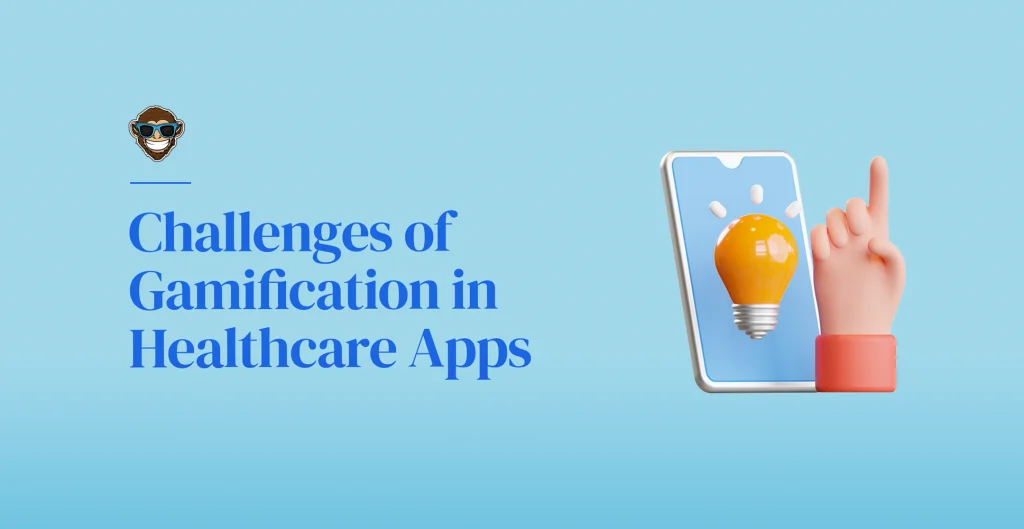
Challenges of Gamification in Healthcare Apps
Poor Design
Unfortunately, as with any other mobile product, no matter how groundbreaking or innovative the idea is, it will bomb if it’s poorly executed. Gamified healthcare apps are no exception. On this point, Gartner predicts that poor design will be the main reason why 80% of gamified apps fail. The reason behind this phenomenon lies in not understanding exactly what goes into the gamification of an app, especially in healthcare. Gamification isn’t only about making an app look like a game. Rewards and badges alone won’t maintain users’ attention, especially if the underlying game UI/UX design doesn’t motivate people to use the app. It’s crucial always to remember that gamification goes beyond simply developing a gaming app. Its primary purpose is to make app navigation seamless and fun and motivate users to keep logging into the app and interacting with its features and elements on a daily basis. For healthcare apps, this means making what would have been an onerous task, like taking your blood pressure, a fun, encouraging endeavor. And, if the design is done right, users will not have to spend too much time searching for an item, entering data, and learning about their conditions, resulting in impeccable UI/UX design and high retention rates.
Data Security And Privacy
Data privacy and security remain a challenge, even in today’s tech-ridden world. For example, one study found that 71% of healthcare apps have at least one high-level security vulnerability. Moreover, out of that 71% of studies apps, 91% have weak encryption. So, as with any digital product that collects, stores, and manages user data, developers must carefully consider how the gamification of the healthcare app and its features will affect and ensure the user’s data privacy and safety. For instance, if the healthcare app links to other apps, like Fitbit, it’s essential to be fully aware of the shared information and how it would affect the patient’s privacy. So, while gamification in healthcare apps can enhance patient motivation, adoption, retention rates, and engagement, safety must always be a top priority at all times, especially as more functionality is added.
It’s also important to keep in mind that gamification doesn’t void the need for regulatory compliance regarding user data. In healthcare apps, privacy is of the utmost importance, which is why they are subject to fierce legislation. The Health Insurance Portability and Accountability Act (HIPAA), for instance, requires developers to ensure the privacy, security, and availability of all medical information that the app stores and shares. On that front, healthcare app developers must add passwords, complex forms of user authentication and authorization, encryption on mobile devices, and keep the app updated and regularly maintained to ensure breaches and hacks are just a distant threat.
Winners and Losers
Let’s face it, we all love winning. In traditional gaming apps and programs, winning is the primary motivator for playing regularly. People download most games with the idea of winning, earning rewards, and unleashing their competitive spirit for the thrill of seeking that coveted victory trophy. Nonetheless, while the thirst for winning a game can effectively motivate users, losing can also be a powerful demotivator, especially in sensitive mobile products like healthcare apps. The threat of losing, or feeling like a loser, may make many users not want to keep playing the game, especially when their progress is shared among other players, which is disastrous in the case of gamified healthcare apps.
To avoid users feeling defeated, developers must implement the right design and game elements based on their user journeys to ensure no one feels defeated. This way, users will understand that the app’s primary purpose isn’t winning or losing but instead maintaining a good routine of checking and logging their daily health status. Similarly, healthcare app designers must be extra sensitive to the issue of losers and winners when considering gamification for their products. Therefore, they need to introduce the necessary elements to ensure that the user experience is always motivating and encouraging.
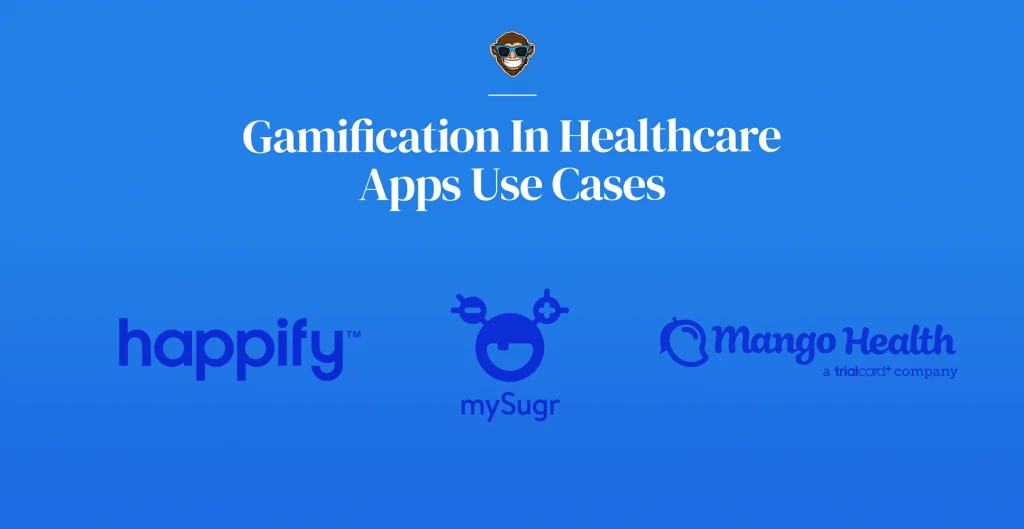
Gamification In Healthcare Apps Use Cases
Happify
Happify was founded in New York in 2012 to make people with mental health issues have a safe space. The app uses gamification to provide users with scientifically backed tools that enable cognitive behavioral therapy. It helps users improve their emotional health with 30 activities that users complete within a week and can help them overcome stress, depression, anxiety and improve their overall mental health. Happify also helps users track their progress by recording how happy or unhappy they feel and lets them visualize how much they are advancing and how much better they are at a given skill. The Happify app claims that more than 86% of its users report feeling happier within two months of using the app.
MySugr
MySugr is a digital health company that developed an app aimed at helping users cope with diabetes. The company implemented a point collection system that enables players to set and reach daily or monthly personal targets. MySugr also allows users to monitor their progress and, through a reward system, encourages them to achieve optimal glucose levels and earn points if they manage to improve them. In a study, the MySugr app improved blood sugar testing frequency by 10-20%. As a result, app users managed to decrease their blood sugar levels by 0.4-1.1%.
Re-mission
Re-mission is a set of online games developed by HopeLabs to help children with cancer cope with the disease. The games consist of robots controlled by patients which fly through the body and destroy cancer cells and tumors using superpowers based on chemotherapy and radiation. The company claims to have helped over 135,000 cancer patients adhere to their treatments and become more motivated to keep fighting the disease.
Mango Health
Mango Health created a gamified mobile app that serves as a pill reminder and health manager. The app helps users get motivated to monitor their health on a daily basis by reminding them to take their medications, receiving rewards for each time they log taking a dose. It also notifies them about dangerous interactions between the drugs they’re taking and other drugs, drinks, or foods. In addition, patients who keep logging their daily intake and do not miss their doses earn points that they can redeem for gift cards.
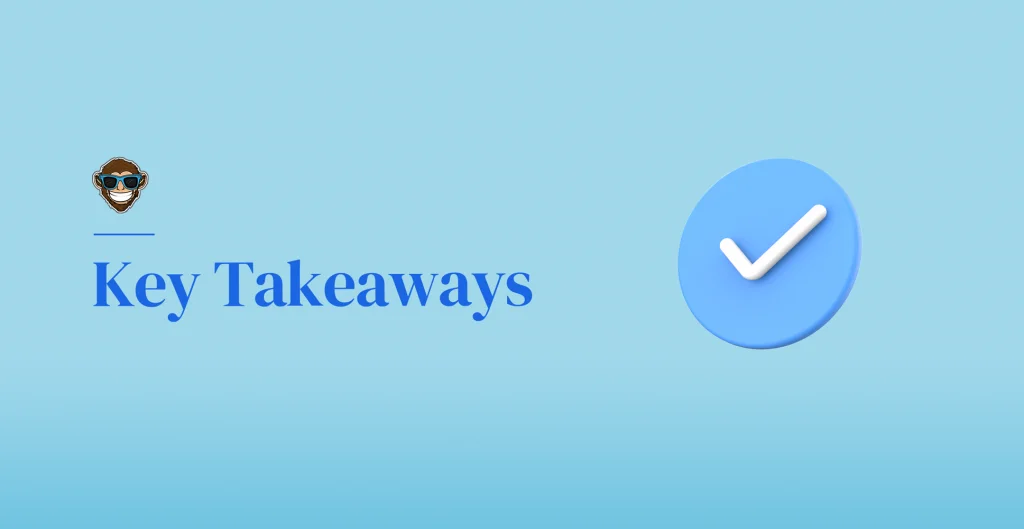
Key Takeaways
It should come as no surprise that slowly changing daily behaviors can positively impact patients’ lives and help prevent disease and disorders. From assisting users in eating healthier foods and maintaining an exercise routine to reminding them to take their medicine, gamification can make daily health-related tasks more fun, engaging, and motivating. Gamified healthcare apps are a fail-safe way of promoting healthy regular activities that, while fun and enjoyable, can also be meaningful and result in long-lasting habits that improve health outcomes. This phenomenon results in a win-win situation for both patients and healthcare providers and often results in better lifestyle awareness, less crowded hospitals, and more manageable illnesses. In that sense, gamification in healthcare apps truly is godsent.
If you want to know more about gamification in healthcare apps or want us to start working on your next project, Let’s talk!
